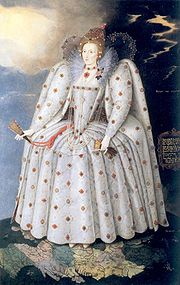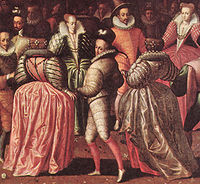
Farthingale
Encyclopedia



Europe
Europe is, by convention, one of the world's seven continents. Comprising the westernmost peninsula of Eurasia, Europe is generally 'divided' from Asia to its east by the watershed divides of the Ural and Caucasus Mountains, the Ural River, the Caspian and Black Seas, and the waterways connecting...
an women's clothing
Clothing
Clothing refers to any covering for the human body that is worn. The wearing of clothing is exclusively a human characteristic and is a feature of nearly all human societies...
in the late 15th and 16th centuries to support the skirt
Skirt
A skirt is a tube- or cone-shaped garment that hangs from the waist and covers all or part of the legs.In the western world, skirts are usually considered women's clothing. However, there are exceptions...
s into the desired shape. It originated in Spain
Spain
Spain , officially the Kingdom of Spain languages]] under the European Charter for Regional or Minority Languages. In each of these, Spain's official name is as follows:;;;;;;), is a country and member state of the European Union located in southwestern Europe on the Iberian Peninsula...
.
Spanish farthingale
The Spanish farthingale was a hoop skirt. Originally stiffened with the subtropical Giant CaneArundo donax
Arundo donax, Giant Cane, is a tall perennial cane growing in damp soils, either fresh or moderately saline. Other common names include Carrizo, Arundo, Spanish cane, Wild cane, and Giant reed....
, later designs in the temperate climate zone were stiffened with osiers (willow cuttings), rope, or (from about 1580) whalebone. It was called verdugado. The name comes from the Spanish
Spanish language
Spanish , also known as Castilian , is a Romance language in the Ibero-Romance group that evolved from several languages and dialects in central-northern Iberia around the 9th century and gradually spread with the expansion of the Kingdom of Castile into central and southern Iberia during the...
verdugo, "green wood", although it also means "executioner" and in modern times that's the more common meaning of the term.
The earliest sources indicate that Princess Joan of Portugal
Joan of Portugal
Joan of Portugal was Queen consort of Castile as the second wife of King Henry IV of Castile and a Portuguese infanta, the posthumous daughter of King Edward of Portugal and his wife Eleanor of Aragon...
started to use verdugadas with hoops in Spain. Joan had provoked much criticism as she allegedly wore dresses that displayed too much décolletage
Décolletage
Décolletage is the upper part of a woman's torso, between her waist and neck, comprising her neck, shoulders, back and chest, that is exposed by the style of her clothing. However, the term is most commonly applied to a neckline which reveals or emphasizes cleavage...
, and her wanton behaviour was considered scandalous. When she started to use farthingales, court fashion followed suit. As Joan had two illegitimate children by Pedro de Castilla y Fonseca rumors abounded that she used the farthingale to cover up a pregnancy. The earliest images of Spanish farthingales show hoops prominently displayed on the outer surfaces of skirts, although later they merely provided shape to the overskirt. The Spanish princess Catherine of Aragon brought the fashion into England on her marriage to Prince Arthur, eldest son of Henry VII in 1501.
Spanish farthingales were an essential element of Tudor fashion in England, and remained a fixture of conservative Spanish court fashion into the early 17th century (see Portrait of Queen Margaret of Austria, 1609), before evolving into the guardainfante of 17th-century Spanish dress.
French farthingale

There are no extant examples of this style of undergarment, and only one drawing—a caricature. From contemporary references (and the visual cues provided by the caricature), it appears to have consisted of a bolster-like roll either stuffed or held out with reeds which, being fastened around the hips, served the purpose of widening the skirts at the hip area, creating drapes.
Some modern costumers conjecture that the French Farthingale and the Great Farthingale refer to one and the same garment, the difference in shape and construction being due to changes in fashion from the 1580s to the 1590s.
Great farthingale
The Great farthingale (a.k.a. The Drum or Wheel or Cartwheel or (rarely) Italian or Catherine-wheel Farthingale in modern times) is the name given to the style of farthingale that evolved from the French Farthingale discussed above, and which became fashionable in the 1590s.Although there are also no surviving examples of this type of garment, there are a number of references to a "Great Farthingale" in Queen Elizabeth I's wardrobe accounts during the time when this style was in vogue. "Great" in this context referring to the large circumference of the farthingale which was required in order to achieve the fashionable silhouette.
The Great Farthingale appears to have been worn at an angle ("low before and high behind") which visually elongated the wearer's torso while shortening their legs. Modern costumers conjecture that it probably consisted of one or more large hoops with horizontal stiffeners which radiated from around the waist in order to produce a flat platter-like shape when supported underneath by the "bumroll" or "French Farthingale" described above.
The Great Farthingale remained in fashion into the first few decades of the 17th century, mostly for Court functions, after which the fashion died out.

